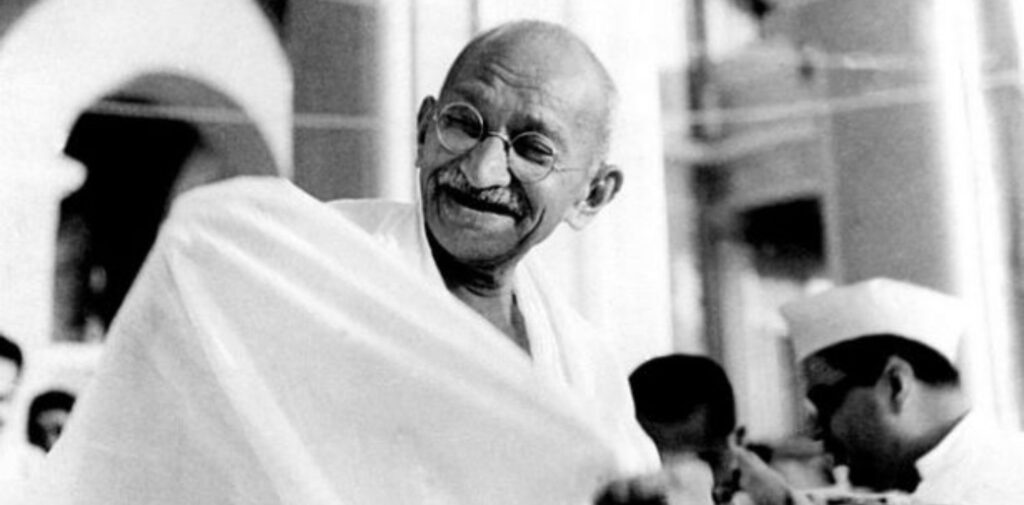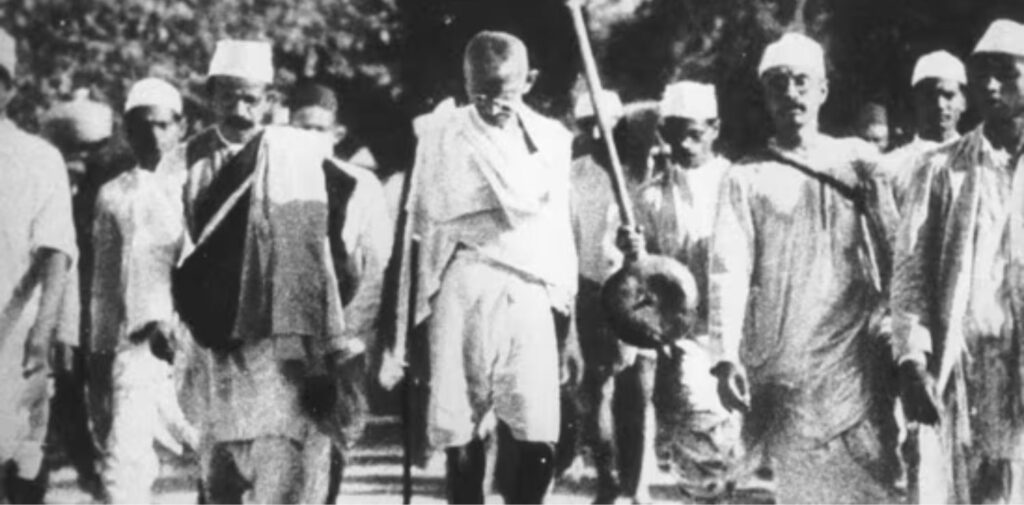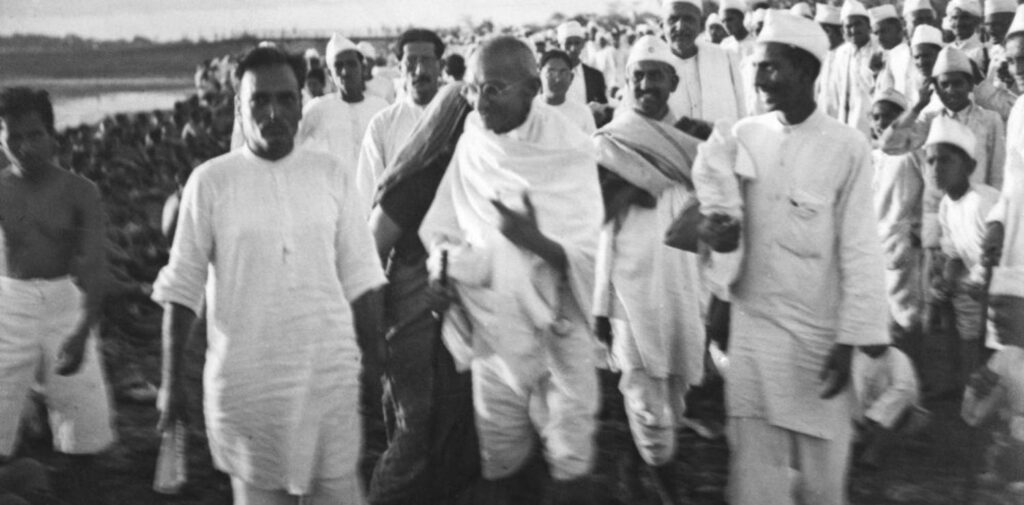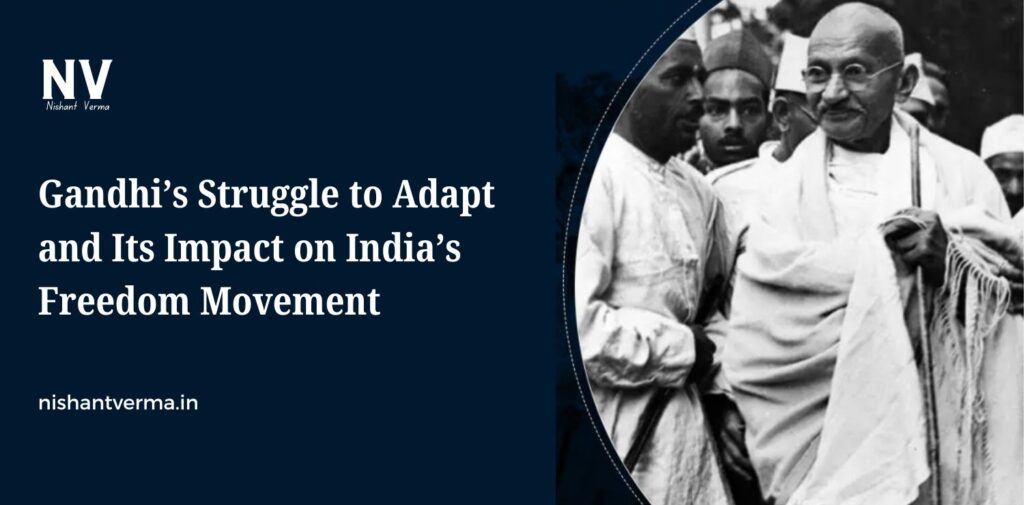Mahatma Gandhi is often hailed as the “Father of the Nation” and is revered for his pivotal role in leading India’s struggle for independence. His philosophy of non-violence, peaceful protests, and civil disobedience inspired millions and played a major part in India freeing itself from British colonial rule. However, Gandhi’s leadership, while revolutionary in many ways, was not without its flaws. One of the biggest criticisms against him was his inability to adapt to the rapidly changing political realities of his time. While his ideals were rooted in the principles of peace and non-violence, these principles sometimes clashed with the urgent demands of a nation striving for freedom.
In this article, we will explore how Gandhi’s reluctance to adjust his methods in the face of changing circumstances affected the Indian Freedom Movement and the long-term consequences of this resistance to change.
Gandhi’s Vision and Early Successes
Gandhi’s vision for India was one of self-reliance, equality, and harmony. His famous philosophy of “Ahimsa” (non-violence) and “Satyagraha” (truth-force) shaped the way he approached the freedom movement. He believed that India could gain independence through peaceful protests, civil disobedience, and boycotts rather than through violent means. This approach was groundbreaking at the time, and it attracted widespread support, especially from the masses who had previously been excluded from political action.
Gandhi’s ability to mobilize millions of people through non-violent means was remarkable. The Salt March in 1930, in which he led a 240-mile protest against the British salt tax, is one of his most famous acts of defiance. The Quit India Movement in 1942, demanding an immediate end to British rule, also demonstrated the power of his non-violent protests.
These movements not only galvanized the Indian population but also drew international attention to the cause of Indian independence. Gandhi’s approach marked a shift away from violent methods of resistance and inspired other global movements for justice and freedom.

The Challenges of Adapting to Changing Political Realities
However, as the freedom struggle progressed, India faced increasingly complex political challenges. Gandhi’s inability to adapt to these changing circumstances created tensions within the Indian National Congress (INC) and with other political groups. There were several key factors that contributed to this problem:
1. The Rise of Radical Elements
By the late 1920s and 1930s, there was a growing frustration among certain groups in India with Gandhi’s leadership. Young radicals like Subhas Chandra Bose and others in the INC began to believe that Gandhi’s methods were too slow and ineffective. They felt that India needed a more aggressive stance to challenge British rule.
While Gandhi remained committed to his methods of non-violence and peaceful resistance, he failed to fully acknowledge the growing desire among certain segments of the population for more direct action. The divide between Gandhi’s approach and the more radical elements in the INC became a point of contention. Bose, for instance, sought to build an armed struggle against the British, which directly contradicted Gandhi’s philosophy.
This gap between Gandhi’s vision and the aspirations of younger, more radical leaders created internal strife within the INC. While Gandhi remained a dominant figure, his inability to accommodate or understand the changing needs of the movement weakened his hold over the growing discontent within the ranks.

2. Inflexibility During World War II
The outbreak of World War II in 1939 marked another critical point where Gandhi struggled to adapt to the shifting political landscape. When the British government declared war on behalf of India without consulting Indian leaders, it led to widespread dissatisfaction and anger. This event provided an opportunity for the Indian leadership to press for independence, but Gandhi’s response was to ask the British to “Quit India” in 1942.
While the Quit India Movement did manage to bring attention to the cause of independence, Gandhi’s demand for an immediate end to British rule was met with severe repression. The British arrested Gandhi and other INC leaders, which resulted in mass protests, but also in the arrest and imprisonment of many important figures of the freedom movement. Gandhi’s insistence on immediate freedom without offering any compromise or negotiation prevented any effective dialogue between India and Britain during this crucial time.
Moreover, Gandhi’s call for non-violence during the Quit India Movement, despite the British crackdown, was seen by some as ineffective. The situation had escalated to the point where many people in India were ready to consider more drastic measures. The lack of flexibility in Gandhi’s leadership made it difficult to address these sentiments.
3. Gandhi’s Focus on Hindu-Muslim Unity
Another area where Gandhi’s refusal to adapt created problems was his focus on Hindu-Muslim unity. Gandhi worked tirelessly for communal harmony between Hindus and Muslims, especially during the period leading up to and after the 1947 partition. He was deeply committed to the idea of a united India, where religious differences could be set aside for the common good.
However, by the time of independence, the political realities had shifted dramatically. The Muslim League, led by Muhammad Ali Jinnah, was increasingly pushing for the creation of Pakistan as a separate Muslim state. Gandhi, despite his best efforts, could not prevent the growing divide between Hindus and Muslims. His insistence on unity, while noble in intent, failed to address the realities of communal tensions and the political aspirations of Muslims in India.
As a result, the partition of India in 1947 led to widespread violence, riots, and the displacement of millions of people. Gandhi’s ideal of Hindu-Muslim unity was overshadowed by the harsh political reality of partition. This failure to adjust his methods to the changing political climate contributed to one of the most tragic and violent episodes in India’s history.

The Consequences of Gandhi’s Inability to Adapt
While Gandhi’s principles were rooted in non-violence and truth, his failure to evolve in response to the shifting political landscape had several significant consequences for India and the freedom movement:
1. Internal Divisions in the Congress Party
Gandhi’s rigid adherence to non-violence and his refusal to adopt more forceful methods of resistance alienated many within the INC, especially the younger generation. This led to internal divisions, with some leaders seeking a more direct approach, while others remained loyal to Gandhi’s peaceful methods. The inability to reconcile these differences weakened the cohesiveness of the movement and created tension within the leadership.
2. Missed Opportunities for Negotiation
At several points in India’s struggle for independence, there were opportunities for negotiation with the British. However, Gandhi’s approach often left little room for compromise. His insistence on absolute independence without any form of negotiation meant that at times, more practical approaches were not fully explored. This resulted in missed opportunities to secure independence through diplomatic means rather than through prolonged protests and violence.
3. The Tragedy of Partition
Perhaps the most tragic consequence of Gandhi’s failure to adapt was the partition of India in 1947. His ideal of Hindu-Muslim unity was deeply challenged by the political reality of the situation. The partition resulted in the division of the subcontinent into India and Pakistan, leading to massive loss of life, displacement, and communal violence. Gandhi’s inability to find a middle ground between the competing demands for a united India and the demands for a separate Muslim state is a bitter chapter in the history of India’s independence struggle.
Conclusion: Indian Freedom Movement
Mahatma Gandhi’s leadership of the Indian freedom movement was both inspirational and transformative. His philosophy of non-violence and his commitment to peaceful resistance played a crucial role in securing India’s independence. However, his failure to adapt to the changing political realities of his time also had a profound impact on the course of the struggle for freedom.
Gandhi’s inability to reconcile the demands of younger, more radical elements within the Congress Party, his rigid stance during World War II, and his idealism regarding Hindu-Muslim unity all contributed to internal divisions, missed opportunities for negotiation, and the painful partition of India. While his ideals of non-violence and unity will always remain important aspects of India’s identity, the challenges he faced in adapting to the rapidly changing political landscape serve as an important lesson in leadership.
Ultimately, while Gandhi’s vision for India was admirable, his inability to adjust his approach to the shifting political realities of his time had lasting consequences for both the freedom struggle and the newly independent nation.




